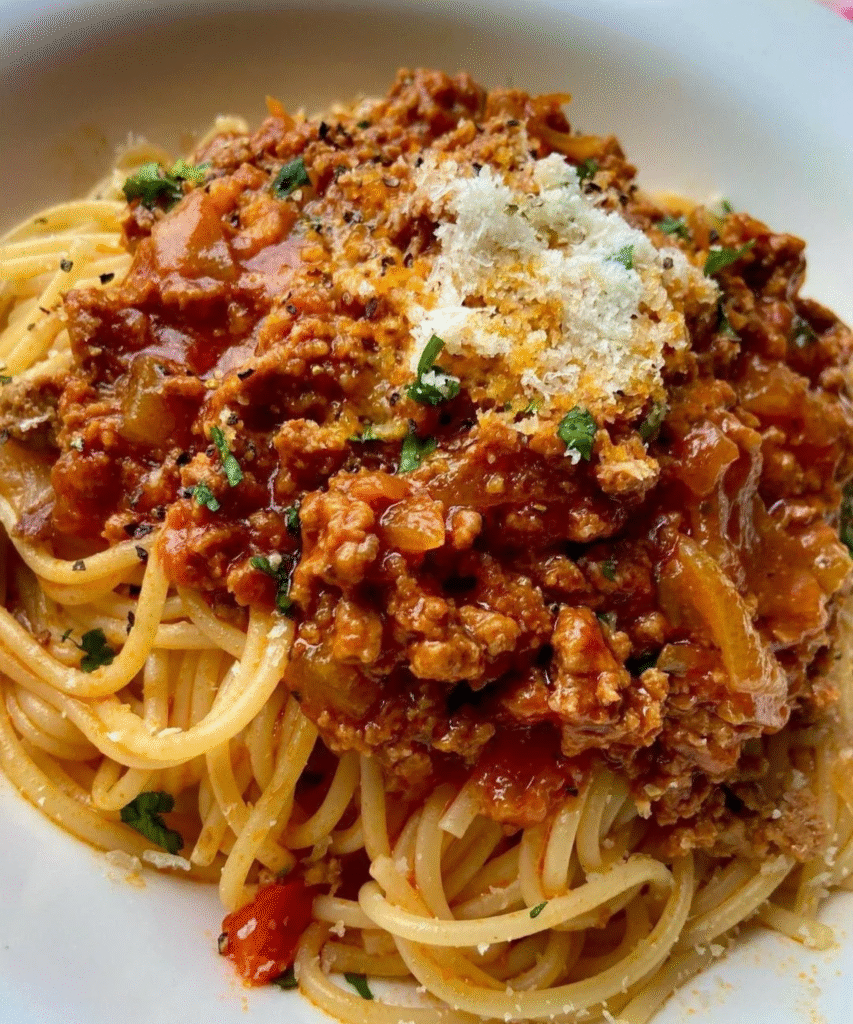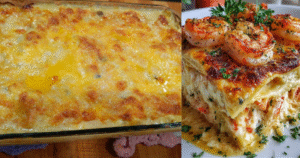The ultimate comfort food that transforms simple ingredients into a rich, soul-warming masterpiece. This authentic spaghetti Bolognese features a slow-simmered meat sauce that develops deep, complex flavors through traditional Italian techniques. While it requires patience, the hands-on time is minimal, making it perfect for a cozy weekend cooking project.
Prep Time: 20 mins
Cook Time: 3 hours
Total Time: 3 hours 20 mins
Servings: 6
Difficulty: Medium
Ingredients
For the Soffritto Base:
- 1 medium onion, finely diced
- 1 large carrot, finely diced
- 2 celery stalks, finely diced
- 4 cloves garlic, minced
- 3 tablespoons extra virgin olive oil
For the Meat Sauce:
- 1 lb ground beef (80/20 blend)
- 1/2 lb ground pork
- 1/2 cup dry white wine
- 1 can (28 oz) San Marzano crushed tomatoes
- 3 tablespoons tomato paste
- 1 cup whole milk
- 1/2 cup beef stock
- 2 bay leaves
- 1 teaspoon dried oregano
- 1/2 teaspoon fresh thyme leaves
- Salt and black pepper to taste
For Serving:
- 1 lb spaghetti pasta
- 1 cup freshly grated Parmigiano-Reggiano cheese
- Fresh basil leaves for garnish

Instructions
- Build the flavor base. Heat olive oil in a heavy-bottomed Dutch oven over medium heat. Add diced onion, carrot, and celery. Cook for 8-10 minutes, stirring occasionally, until vegetables soften and onion becomes translucent. The vegetables should release their moisture and begin to caramelize slightly.
- Add aromatics. Stir in minced garlic and cook for another minute until fragrant. This soffritto base is the foundation of authentic Bolognese flavor.
- Brown the meat. Increase heat to medium-high. Add ground beef and pork, breaking it apart with a wooden spoon. Cook for 6-8 minutes until meat loses its pink color and develops golden-brown bits. The meat should sizzle and release its juices.
- Deglaze with wine. Pour in white wine, scraping up any browned bits from the bottom of the pot. Let wine simmer for 2-3 minutes until alcohol cooks off and liquid reduces by half.
- Add tomato elements. Stir in tomato paste and cook for 1 minute until it darkens slightly. Add crushed tomatoes, breaking up any large pieces with your spoon. The mixture should bubble gently.
- Create the long simmer. Add milk, beef stock, bay leaves, oregano, and thyme. Season with 1 teaspoon salt and 1/2 teaspoon pepper. Bring to a gentle simmer, then reduce heat to low.
- Slow-cook to perfection. Partially cover and simmer on low heat for 2.5-3 hours, stirring every 30 minutes. The sauce should barely bubble and gradually thicken. Add more stock if it becomes too thick. The finished sauce will coat a spoon and have a rich, deep color.
- Cook the pasta. During the last 15 minutes of sauce cooking, bring a large pot of salted water to boil. Cook spaghetti according to package directions until al dente. Reserve 1 cup pasta water before draining.
- Marry pasta and sauce. Remove bay leaves from sauce. Add drained pasta directly to the sauce pot with 1/4 cup pasta water. Toss for 2 minutes over low heat until pasta absorbs some sauce and appears glossy.
- Serve immediately. Divide among warmed bowls and top generously with Parmigiano-Reggiano cheese. Garnish with fresh basil leaves and serve with additional cheese on the side.
Tips for Success
Low and Slow is Key: The magic of Bolognese happens during the long, gentle simmer. High heat will cause the sauce to reduce too quickly and develop harsh flavors. The sauce should barely bubble throughout cooking.
Milk Makes a Difference: Adding milk early in the cooking process tenderizes the meat and adds richness. Don’t skip this traditional ingredient – it’s what separates authentic Bolognese from regular meat sauce.
Vegetable Size Matters: Dice vegetables finely and uniformly so they break down during the long cooking process. Large chunks won’t integrate properly and will detract from the smooth sauce texture.
Pasta Water is Gold: The starchy pasta water helps bind the sauce to the spaghetti. Always reserve some before draining, and don’t be afraid to use it generously when combining.
Recipe Variations
Bolognese Bianco: Skip the tomatoes entirely for a white wine and milk-based sauce that highlights the meat flavor. Increase wine to 1 cup and milk to 1.5 cups.
Turkey Bolognese: Substitute ground turkey for half the beef and pork. Add an extra tablespoon of olive oil since turkey is leaner than traditional meats.
Vegetable-Heavy Version: Double the carrots and celery, and add diced zucchini or mushrooms. This creates a heartier texture while maintaining authentic flavors.
Make-Ahead Option: The sauce actually improves overnight. Cool completely, refrigerate for up to 3 days, then reheat gently with a splash of stock if needed.
Storage Instructions
This spaghetti Bolognese sauce freezes beautifully for up to 3 months. Cool completely before transferring to freezer containers, leaving 1 inch of headspace for expansion.
For refrigerator storage, the sauce keeps for 4-5 days in airtight containers. The flavors continue developing, often tasting even better on day two or three.
When reheating, add a splash of beef stock or pasta water if the sauce seems thick. Heat gently over low heat, stirring occasionally, until warmed through.
Nutritional Highlights
This traditional Bolognese provides complete protein from the meat blend and complex carbohydrates from pasta. The long cooking process breaks down vegetables into easily digestible nutrients while concentrating their vitamins.
The combination of beef and pork offers iron, B vitamins, and zinc. Using whole milk adds calcium and helps create the sauce’s signature creamy texture without heavy cream.
Serving Suggestions
Authentic spaghetti Bolognese needs little accompaniment beyond good cheese and perhaps a simple green salad. The dish shines on its own, especially when served in warmed bowls that keep every bite at optimal temperature.
Pair with a medium-bodied red wine like Chianti Classico or Sangiovese. The wine’s acidity cuts through the rich sauce while complementing the herb and tomato flavors.
For special occasions, start with antipasti featuring Italian cured meats and cheeses, then follow the Bolognese with a light dessert like tiramisu or panna cotta.
This recipe proves that some of life’s greatest pleasures come from simple ingredients treated with respect and patience. The slow transformation of basic vegetables, meat, and tomatoes into something transcendent is what makes spaghetti Bolognese a timeless classic worth mastering.



